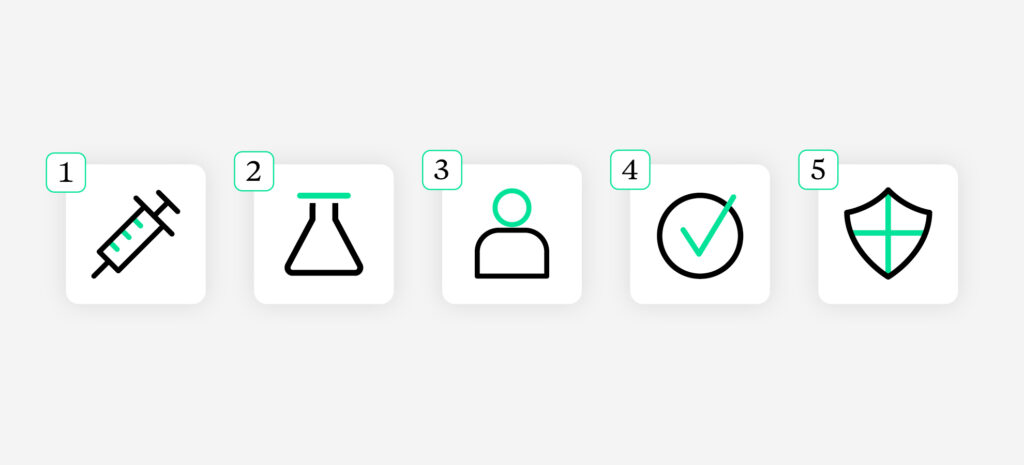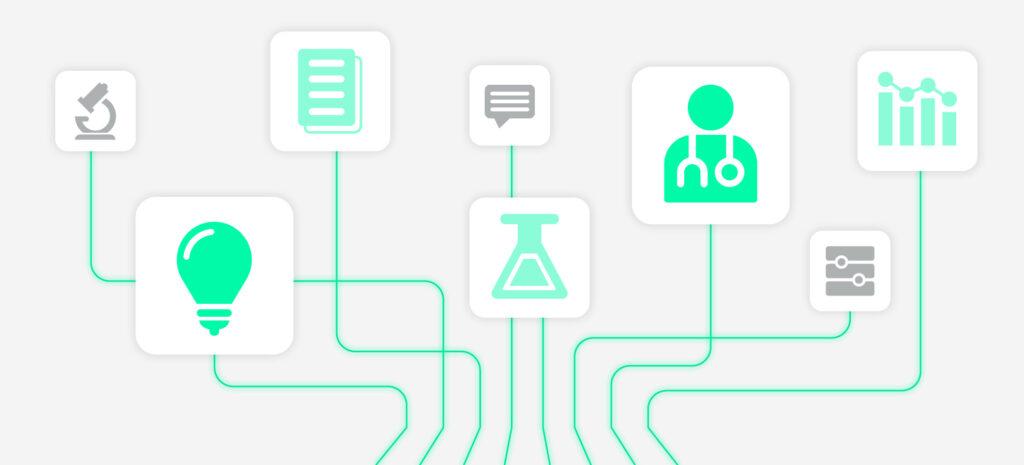Before a drug can be used by patients, it goes through rigorous testing for safety, efficacy, and cost-effectiveness. In this article, we’ll discuss the role of research and development in the pharmaceutical industry, what is most important at each stage of the pharma R&D process, and how insights management can help clinical R&D teams improve their in conjunction with pharma R&D analytics.
What are the key stages of drug development?
According to Northeast Biolab, “The complexity in drug development has increased manifold over the past 40 years, requiring preclinical testing, investigational new drug (IND) applications, and completed clinical testing before the FDA regulatory approval for marketing. Generally, new drug applications (NDAs) or biologics license applications (BLA) are reviewed comprehensively before approval, and then drug performance is resubmitted to regulatory agencies for post-marketing studies. The overarching goal is to bring more efficient and safer treatments to the patients as quickly as possible after a thorough medical evaluation.”
With some variation due to organizational differences, there are five phases of the development process for new drugs. How does clinical research work?
Discovery
The U.S. Food and Drug Administration (FDA) describes the discovery phase as follows. Typically, researchers discover new drugs through:
- New insights into a disease process allow researchers to design a product to stop or reverse the effects of the disease.
- Many tests of molecular compounds to find possible beneficial effects against any of a large number of diseases.
- Existing treatments with unanticipated effects.
- New technologies, such as those that provide new ways to target medical products to specific sites within the body or to manipulate genetic material.
At this point, there are many compounds – perhaps thousands – that may be potential candidates for development as a medical treatment. But after early testing, only a small number of compounds are promising enough to call for further study.
Preclinical testing
Preclinical testing of new drugs employs in-vivo animal studies. Preclinical testing requires high levels of proficiency in veterinary medicine and care, highly specialized personnel, facilities, equipment, and adherence to stringent guidelines if the reports and data resulting from a study are to be found of sufficient quality by regulatory reviewers so that the new drug candidate can advance to the clinical trial or development phase.
Clinical development
According to the US FDA, “While preclinical research answers basic questions about a drug’s safety, it is not a substitute for studies of ways the drug will interact with the human body. “Clinical research” refers to clinical studies, or clinical trials, that are done in people. As the developers design the clinical study, they will consider what they want to accomplish for each of the different Clinical Research Phases and begin the Investigational New Drug Process (IND), a process they must go through before clinical research begins.”
This phase is fraught with challenges including patient identification, enrollment, engagement, and data collection that may require years to gather with sufficient detail and volume to satisfy regulatory requirements for drug approval.
FDA review
In this phase, a drug developer can file an application to market the drug. Approval of this application depends on whether or not the drug developer has evidence from its early tests and preclinical and clinical research that a drug is safe and effective for its intended use. When the application is filed, an FDA review team thoroughly examines all submitted data on the drug and makes a decision to approve or not to approve it.
Post-market monitoring
After drug approval, a complete picture of product safety emerges over the months and years of a product’s lifetime in the marketplace. During post-market monitoring, the FDA reviews reports of problems with prescription and over-the-counter drugs, and if necessary can decide to add cautions to the dosage or usage information, as well as other measures for more serious issues.
How long does the drug development process take?
This highly complex and detailed process underscores the need for systems or tools that allow concerned parties to communicate clearly, quickly, and inclusively. Novel pharmaceutical therapeutics can take several years to reach the market, and fewer than 10% of all drugs in development make it to market from phase 1 clinical trials. With a trial-to-market efficacy rate of 14%, the average cost to successfully develop a single drug is around $2 billion. Even if success is achieved, this high-risk, high-reward endeavor has a relatively short time to pay off development costs given patent expiration and the introduction of low-cost generic competitors.
Why is a rigorous development process important?
Regulatory bodies are responsible for assuring the safety and efficacy of new drugs that become available for patient treatment, and that those drugs are only prescribed or administered for conditions that meet the drug’s labeling. In the US, “FDA approval of a drug means that data on the drug’s effects have been reviewed by the Center for Drug Evaluation and Research (CDER), and the drug is determined to provide benefits that outweigh its known and potential risks for the intended population.”
Because healthcare providers and patients rely on drugs to be safe and to improve their health and quality of life, the drug approval process is highly structured. The approval framework includes:
- Analysis of the target condition and available treatments, in which FDA reviewers analyze the condition or disease for which the drug is intended and evaluate the current treatment landscape. This provides context for weighing the drug’s risks and benefits.
- Assessment of benefits and risks from clinical data, in which the FDA reviewers evaluate clinical benefit and risks information submitted by the drugmaker. Generally, the FDA expects the pharmaceutical company or biopharma company will submit results from two well-designed clinical trials to ensure that findings from the first trial are not the result of chance or bias.
- Risk management strategies, including an FDA-approved drug label that clearly describes the drug’s benefits and risks, and how those risks can be detected and managed. In some cases, a pharma company may be required to implement a Risk Management and Mitigation Strategy or REMS.
Off-label use of drugs requires drug developers to submit clinical data and other information to the FDA for review, demonstrating that the drug is safe and effective for its intended uses. Patients prescribed a drug for its approved use can be sure that:
- The FDA has conducted a careful evaluation of its benefits and risks for that use.
- The decision to use the drug is supported by strong scientific data.
- There is approved drug labeling for healthcare providers on how to use the drug safely and effectively for that use.
How can insights management technology help the pharma R&D process?
For the patients that need life-changing therapies, as well as the companies that develop, produce, and sell them, speed to market is a top priority in a process that takes years and enormous amounts of resources.
Disparate teams from multiple large organizations, especially regulatory bodies and clinical R&D teams, need access to insights accumulated throughout the development process in order to accomplish one of the greatest challenges in life science innovation: successfully developing a new drug that can save, extend, and improve lives. Enabling these innovations by taking advantage of pharma R&D trends, such as new technology, is one way drug companies will seek to create a competitive edge in the years to come.
Within3’s insights management platform was developed to unify the process of gathering, collating, and interpreting data from preclinical research through post-market monitoring. Pharmaceutical companies who use insights management technology to streamline the process of insight gathering across the development process can shorten timelines, reduce costs, and most importantly, get a more accurate picture of any disease community or prevailing HCP sentiment about a product.
As pharmaceutical companies increasingly embrace digital transformation in other organizational sectors, clinical, medical affairs, and commercial teams will be required to match the speed of other teams equipped with automation, artificial intelligence, machine learning, and other tech tools that accelerate business processes.
To learn more about how insight gaps can affect different stages of the drug development process, read our white paper.






